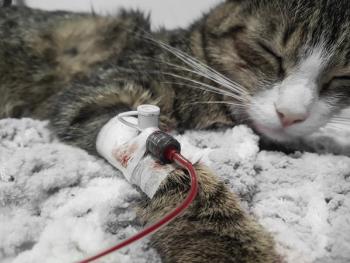
Is Babesiosis Declining in South Africa?
Investigators found that over a 6-year period the number of babesiosis cases decreased as the number of canine veterinary visits rose.
Babesiosis, also known as biliary fever, is caused by a eukaryotic protozoal parasite that infects the red blood cells (RBCs) of canines and other vertebrates. Babesia rossi and Babesia vogeli are causative agents of babesiosis in South Africa, although B rossi is significantly more virulent. Infection is transmitted through tick bites in this region where wild canines, such as jackals, serve as natural hosts. Transmission of B rossi occurs roughly 24 hours after tick attachment to the host, and signs can present in as little as 2 weeks. Some dogs do not develop signs, and native canine species to this region have developed immunity following infection as juveniles.
Symptomatic disease resembles that of severe anemia, including pale color, tachycardia, tachypnea, and respiratory distress, as well as cerebral effects, enterorrhagia, acute renal failure, and pulmonary edema. D rossi causes destruction of RBCs through intracellular reproduction and subsequent cell lysis. In some cases, a massive release of cytokines causes systemic effects as well. Roughly 30% of babesiosis cases require hospitalization and more intensive treatment, and death occurs in more than 10% of cases.
RELATED:
- New Insights on Babesia canis Transmission in Dogs
- A Novel Quantitative PCR Assay Improves Detection of Babesia
Treatment for babesiosis includes administration of antiparasitics, supportive care, and blood transfusions as needed. In recent years, veterinarians in South Africa have reported seeing fewer babesiosis cases, although statistical data have not been not available to confirm the perceived decline. A study recently published in
Study Design
The investigators examined babesiosis trends in 44 South African veterinary hospitals through an observational study from 2011 to 2016. Participating hospitals were required to have a proprietary medical records management system, have maintained data for at least 1 year during the study period, and be willing to give signed consent for searching and downloading medical records.
The study population included all dogs brought to participating veterinary hospitals during the study period, regardless of the reason for the visit. The investigators searched patient records for the use of diminazene aceturate and imidocarb diproprionate—antiparasitics used exclusively to treat babesiosis. To calculate the healthcare use rate (HUR), the sum of the total of canine babesiosis treatments was divided by the total number of canine visits to all participating practices.
Results
After screening 2.6 million canine visits, the investigators found that babesiosis rates declined from 1.18% to 0.33% over the course of the study period. There was a 72% decline in babesiosis treatments between 2011 and 2016, with the largest decrease in 2015 and 2016. Canine visits increased by single digits during the study period, while the number of babesiosis treatments fell by 20% to 30% annually.
Conclusion
The investigators speculated that socioeconomic factors likely played a role in the increased number of canine visits over the study period, and use of tick preventives recommended during these visits could be a potential reason for the decrease in babesiosis cases in the region. The medical records were screened for drugs used in treatment of babesiosis; thus patients euthanized due to babesiosis were not included in the rate calculation. The researchers did not comment on whether routine procedures, such as nail trims and anal sac expressions, were included in the calculations and whether these types of visits might have skewed HUR estimates.
Further studies are needed to determine the cause of the reduction in babesiosis cases seen. Approval and introduction in South Africa in 2014 of a new class of acaricidal molecules, the isoxazolines, may have contributed to the decrease. However, causal determination cannot be drawn due to the methodology of this study.
Dr. Bohn received her PhD and MS from Georgia State University and has been a practicing veterinary nurse for nearly 20 years. She provides freelance medical writing services through her business, Bohn Communications.
Newsletter
From exam room tips to practice management insights, get trusted veterinary news delivered straight to your inbox—subscribe to dvm360.




